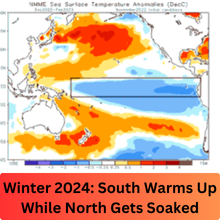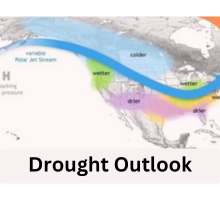
The upcoming winter from December 2024 to February 2025 is expected to be influenced by a developing La Niña pattern. This article will break down what this means for various regions across the United States, focusing on temperature, precipitation, and drought conditions. Let’s dive into the details and see how this winter will unfold!
Understanding La Niña
What is La Niña?
La Niña is a climate pattern characterized by cooler-than-average sea surface temperatures in the central Pacific Ocean. It influences weather patterns worldwide, often bringing increased precipitation to some areas while drying out others.
Impact on Winter Weather
This year, the developing La Niña is expected to affect the winter weather forecast significantly. NOAA predicts it will lead to a more northerly storm track, which typically results in wetter conditions for the northern U.S. and drier weather for the southern regions.
Temperature Predictions
Warmer Conditions in the South
NOAA’s forecast indicates that the southern tier of the U.S. is likely to experience warmer-than-average temperatures. This trend extends through the Gulf Coast, Texas, and the eastern Great Lakes, where residents can expect milder conditions.
Cooler Weather Up North
Conversely, southern Alaska is anticipated to see below-average temperatures. There may also be slight dips in temperatures from the Pacific Northwest to the northern High Plains, providing a stark contrast to the warmer southern states.
Precipitation Patterns
Wetter Conditions in the North
If you live in the northern tier of the U.S., get ready for some wet weather! The Great Lakes region, Pacific Northwest, and northern Alaska are all projected to receive above-average precipitation. This could mean more snow for those enjoying winter sports!
Drier Days Ahead in the South
Meanwhile, states in the southern U.S. are expected to be drier than usual. Areas from the Four Corners region to the Southeast and Gulf Coast might face challenges due to a lack of moisture. This could have implications for agriculture and water supply in these areas.
Drought Outlook
Continuing Drought in the Central Plains
Unfortunately, drought conditions are expected to persist across much of the Great Plains and southern regions. After a brief respite in the spring of 2024, over 25% of the continental U.S. is currently facing at least moderate drought.
Potential Improvements in the North
On a more positive note, the Ohio River Valley and Great Lakes region may see drought conditions improve or even end altogether. These areas might benefit from the wetter conditions predicted for this winter.
NOAA’s Innovative Forecasting Tools
Upgrades to Winter Forecasting
In preparation for this winter, NOAA has made significant investments in its forecasting tools. A $100 million investment aims to enhance research on weather and climate predictions, which is essential for accurate seasonal outlooks.
Also read: Is Steve Harvey Really Dead? Shocking Rumor Explained
New Tools for Better Understanding
NOAA has also launched several new products to help the public understand winter hazards better. For example, the Probabilistic Winter Storm Severity Index (WSSI-P) visually represents potential winter impacts over a seven-day period, aiding in planning and safety measures.
What to Expect in Specific Regions
Pacific Northwest
Residents of the Pacific Northwest should brace for a wetter winter, with above-average precipitation likely. This could mean increased snowfall in the mountains, benefiting skiers and snowboarders.
Great Lakes Region
Those in the Great Lakes states can expect similarly wet conditions. The increased moisture will be vital for replenishing water supplies and supporting local ecosystems.
Southern States
If you’re in the southern U.S., prepare for a warm and dry winter. This could lead to increased risks of drought, affecting agriculture and water management efforts.
The Bigger Picture
Climate Change Implications
The ongoing changes in climate patterns, such as La Niña and its impacts, highlight the importance of understanding weather systems. Recognizing these trends can help communities better prepare for the challenges ahead.
Community Preparedness
NOAA’s seasonal outlooks serve as a vital resource for communities, helping them prepare for what’s to come. By providing actionable forecasts, residents can take steps to mitigate potential weather impacts on their lives and livelihoods.
Also read: Dallas Wings Fire Coach Latricia Trammell: Shocking Move!
Conclusion
The U.S. Winter Outlook for 2024-2025 indicates a warmer and drier South alongside a wetter North, significantly influenced by the developing La Niña. As we prepare for the winter months, understanding these trends can help us stay ahead of the weather and adapt accordingly. Whether you’re in the sunny South or the snowy North, there’s much to anticipate this winter!
FAQs
What does the winter outlook predict for the southern U.S.?
The southern U.S. is expected to experience warmer and drier conditions this winter.
How will La Niña affect winter weather?
La Niña typically leads to a more northerly storm track, resulting in wetter conditions in the northern U.S. and drier conditions in the South.
Which areas will see increased precipitation?
Wetter-than-average conditions are expected in the northern tier, especially in the Great Lakes and Pacific Northwest.
Are drought conditions expected to improve?
Drought conditions may improve in the Ohio River Valley and Great Lakes region, but the Great Plains and southern states are likely to remain dry.
How can I prepare for winter weather?
Stay informed through NOAA’s updates, and take proactive measures based on local forecasts to minimize weather-related impacts on your daily life.

